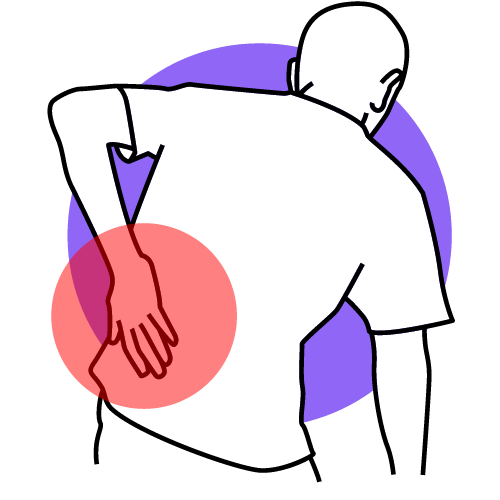Back Pain Dallas

Back Pain Specialist Dallas, TX
Innovative Therapy PC is your premier destination for expert care from a back pain specialist in Dallas, Texas. Back pain can be debilitating, affecting your ability to work, sleep, and enjoy daily activities. Our experienced specialists are dedicated to providing compassionate care and effective treatment options to help you find relief and improve your quality of life.
Our back pain specialists are highly trained in diagnosing and treating various back conditions, including muscle strains, disc herniations, spinal stenosis, and degenerative disc disease. We take a comprehensive approach to care, considering your medical history, symptoms, and lifestyle factors to develop personalized treatment plans tailored to your needs.
Using the latest advancements in medical technology and evidence-based practices, we offer various treatment options for back pain, including physical therapy, medication management, injections, and minimally invasive procedures. Our goal is to alleviate your pain, address the underlying cause of your symptoms, and prevent future recurrences.
Don’t let back pain hold you back from living your best life. Contact Innovative Therapy PC today to schedule a consultation with one of our back pain specialists and take the first step towards a pain-free future.
Treatment for Back Pain in Dallas, Texas

When it comes to finding effective treatments for back pain in Dallas, Texas, Innovative Therapy PC is your trusted partner. We understand that back pain can be a complex and challenging condition to manage, so we offer a comprehensive range of treatment options tailored to your needs.
Our experienced team of healthcare professionals specializes in diagnosing and treating various back conditions, including muscle strains, herniated discs, sciatica, and spinal arthritis. We take a holistic approach to care, addressing not only your symptoms but also the underlying causes of your pain to provide long-lasting relief.
From conservative treatments such as physical therapy, chiropractic care, and acupuncture to advanced interventions, including epidural steroid injections, nerves blocks, and minimally invasive spine surgery, we offer various options to help you find relief from back pain. We aim to restore function, improve mobility, and enhance your overall quality of life.
At Innovative Therapy PC, we prioritize patients education, communication, and support, ensuring you are actively involved in your treatment plan every step. Don’t let back pain limit your activities or diminish your enjoyment of life any longer. Contact us today to schedule a consultation and take the first step towards a pain-free future.
Top Back Pain Doctors Near Dallas, TX
If you’re searching for the top back pain doctors near Dallas, TX, look no further than Innovative Therapy PC. Our board-certified physicians and specialists are leaders in orthopedic medicine, with extensive experience and expertise in diagnosing and treating various back conditions.
From acute injuries to chronic degenerative diseases, we offer personalized treatment plans tailored to your needs and goals. Our comprehensive approach to care combines conservative therapies, advanced interventions, and rehabilitation techniques to provide superior outcomes for our patients.
At Innovative Therapy PC, we understand the impact back pain can have on your daily life, so we prioritize compassionate care and patients satisfaction. We’ll work with you every step of the way to ensure that you receive the highest level of service and support throughout your treatment journey.
Don’t let back pain hold you back from living your best life. Choose Innovative Therapy PC for expert care and personalized attention that you can trust. Contact us today to schedule a consultation and experience the difference for yourself.
Causes of Back Pain Conditions – Dallas, TX
Back pain is a common condition that a variety of factors can cause. In Dallas, TX, Innovative Therapy PC is here to help you understand the potential causes of your back pain and provide effective treatment options to alleviate your symptoms.
Some common causes of back pain include muscle strains and sprains, herniated discs, spinal stenosis, arthritis, and degenerative disc disease. Other factors such as poor posture, obesity, lack of exercise, and sedentary lifestyle can also contribute to back pain.
At Innovative Therapy PC, our team of experts specializes in diagnosing and treating the underlying causes of back pain. We take a comprehensive approach to care, addressing your symptoms and the root cause of your pain to provide long-lasting relief.
Whether you’re dealing with acute back pain from an injury or chronic back pain from a degenerative condition, we offer personalized treatment plans tailored to your needs and goals. From conservative therapies such as physical therapy and medication management to advanced interventions, including injections and minimally invasive surgery, we have the expertise and resources to help you find relief from back pain.
Don’t let back pain control your life any longer. Contact Innovative Therapy PC today to schedule a consultation and take the first step toward a pain-free future.

Back Pain Relief and Remedies | Spine Center
At Innovative Therapy PC, we understand back pain’s impact on your daily life. That’s why we offer a variety of innovative treatments and remedies to help you find relief and get back to doing the things you love. Our team of experts specializes in diagnosing and treating various back conditions, including muscle strains, herniated discs, sciatica, and spinal arthritis. We take a personalized approach to care, developing customized treatment plans tailored to your specific needs and goals.
From conservative treatments such as physical therapy, chiropractic care, and massage therapy to advanced interventions, including epidural steroid injections, nerve blocks, and regenerative medicine therapies, we offer a comprehensive range of options to address your back pain.
In addition to our clinical treatments, we provide education and support to help you manage your symptoms and prevent future recurrences. Whether you’re dealing with acute back pain from an injury or chronic back pain from a degenerative condition, we’re here to help you find relief and improve your quality of life. Don’t let back pain hold you back any longer. Contact Innovative Therapy PC today to schedule a consultation and take the first step toward a pain-free future.
“80% of Americans will experience lower back pain at some point in their lives”
After surgery, it is important to start physical therapy as soon as possible. Physical therapy can help to reduce pain and swelling, and it can also help to improve your range of motion and strength. exercises that stretch and strengthen the muscles around the incision site can be especially helpful in reducing pain and promoting healing.
Physical therapy can help to reduce muscle spasms and improve range of motion, both of which can lead to significant back pain relief.
Physical therapy can help to stretch and strengthen the muscles around the SI joint, providing support and helping to prevent further injury.
Physical therapy is an effective treatment for disc herniation and will work with you to strengthen the muscles around the affected area and improve your flexibility.
Through exercises and stretches, physical therapy can help to relieve pressure on the discs and improve flexibility. In addition, they can also teach you how to properly support your back and avoid activities that could aggravate your condition.
Physical therapy can help to relieve the pain and stiffness associated with facet joint syndrome through exercises and manual therapy.
Back Ailments That I Treat
FAQs About Back Pain | Spinal Problems Dallas
Who is the best person to see for back pain?
The best person to see for back pain is a healthcare professional specializing in diagnosing and treating spine-related conditions. This can include a physical therapist, chiropractor, orthopedic surgeon, or pain management specialist. At Innovative Therapy PC in Dallas, TX, we have experienced therapists who can provide personalized care for your back pain.in can arise from a variety of causes. Some of the most common include:
- Muscle or Ligament Strain: Repeated heavy lifting or sudden awkward movements can strain back muscles and spinal ligaments.
- Bulging or Ruptured Disks: Disks act as cushions between the bones (vertebrae) in the spine. The soft material inside a disk can bulge or rupture and press on a nerve.
- Arthritis: Osteoarthritis can affect the lower back, and in some cases, arthritis in the spine can lead to a narrowing of the space around the spinal cord, a condition called spinal stenosis.
- Skeletal Irregularities: Conditions like scoliosis, a curvature of the spine, can lead to back pain.
Osteoporosis: Bones becoming porous and brittle can lead to compression fractures in the vertebrae.
Where is the best place to go for back pain?
The best place to go for back pain is a reputable clinic or healthcare facility specializing in musculoskeletal conditions and offering various treatment options. In Dallas, TX, Innovative Therapy PC is known for its comprehensive approach to treating back pain, utilizing the latest techniques and therapies to help patients achieve relief.
Who should I go to for severe back pain?
For severe back pain, consulting with a specialist such as an orthopedic surgeon or a pain management physician is recommended. These professionals can assess the severity of your condition and suggest appropriate treatment options, including medication, physical therapy, or surgery if necessary.
At what point do I go to the ER for back pain?
You should go to the ER for back pain if you experience symptoms such as loss of bowel or bladder control, numbness or weakness in the legs, severe and sudden pain, or if the pain is a result of a traumatic injury. These could be signs of a severe condition that requires immediate medical attention.
Will the ER do anything for back pain?
The ER can provide immediate care for acute back pain, especially related to a severe condition or injury. They may offer pain relief medication, perform diagnostic tests, and refer you to a specialist for further treatment. However, it is often more effective to seek treatment from a specialist or a clinic like Innovative Therapy PC for chronic back pain.
How do I know if my back pain is severe?
Back pain is considered severe if it is intense, lasts more than a few days, or is accompanied by other symptoms such as fever, unexplained weight loss, or neurological symptoms like numbness or weakness. If you experience these signs, seeking medical attention to determine the underlying cause and appropriate treatment is essential.
